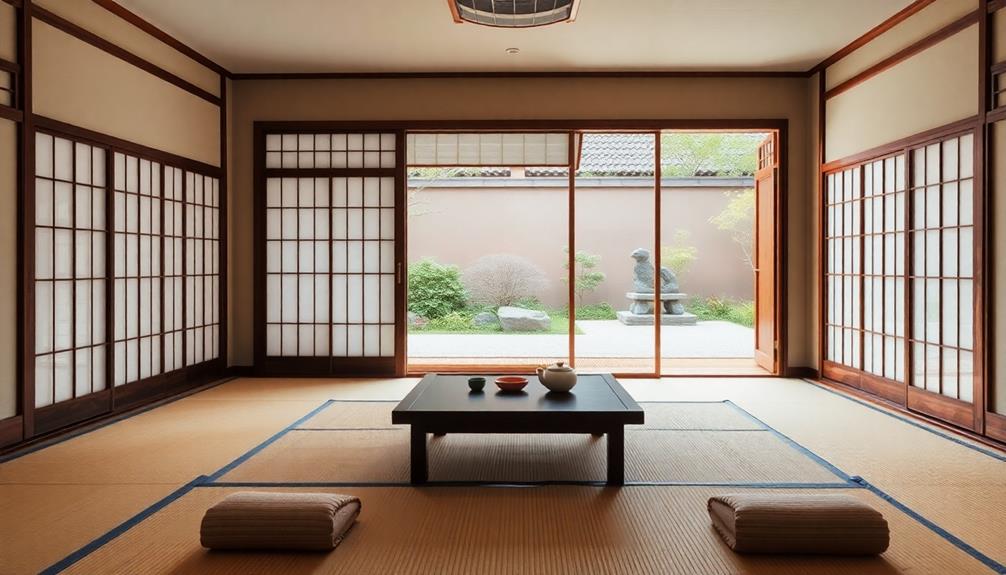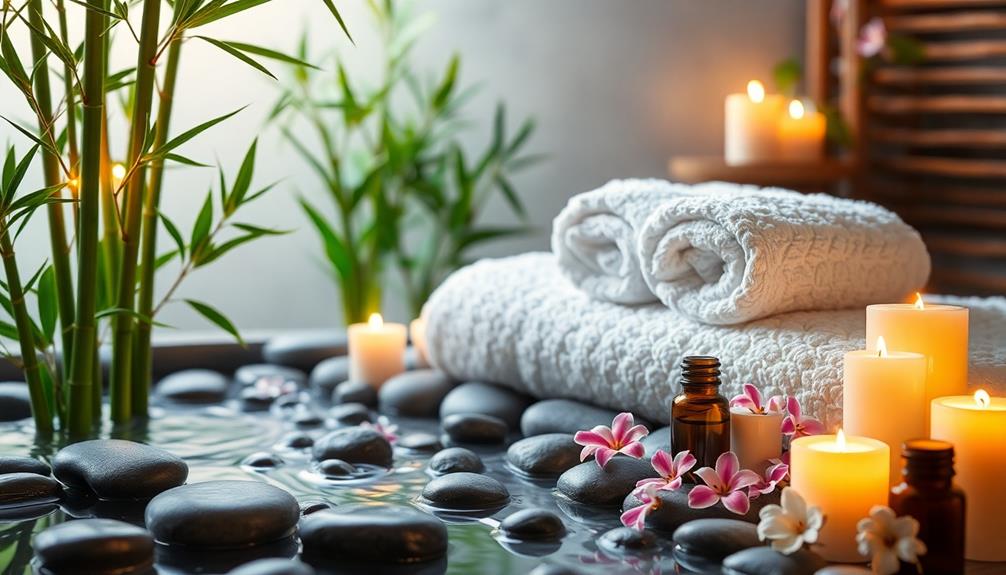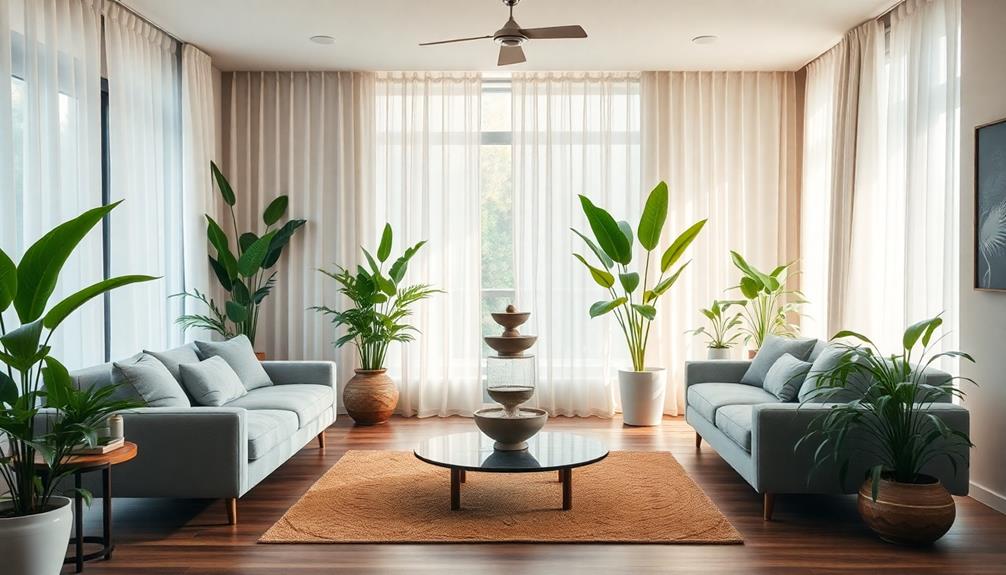Japanese interior design embodies the art of simplicity, combining minimalism with tranquility. You'll appreciate the use of natural materials like wood, bamboo, and stone, which create a serene environment. Neutral color palettes foster calmness, while thoughtful spatial organization enhances balance and flow. The principles of Ma (negative space) and Wabi-Sabi embrace openness and beauty in imperfection, giving your space character. This design approach enchants people worldwide, promoting wellness through mindfulness and functional elegance. If you're curious about how to incorporate these principles into your own home, there's much more to discover about this enchanting style.
Key Takeaways
- Japanese interior design emphasizes simplicity through natural materials like wood, bamboo, and stone, creating a serene atmosphere.
- The principles of Wabi-Sabi celebrate beauty in imperfection, enhancing the aesthetic value of spaces.
- Mindful spatial organization and clutter reduction promote tranquility and a sense of flow within living areas.
- Neutral color palettes and clean lines contribute to a calming environment, reflecting the elegance of minimalism.
- Integration of multifunctional furniture and smart technology enhances convenience while maintaining the essence of simplicity.
Cultural Foundations of Minimalism
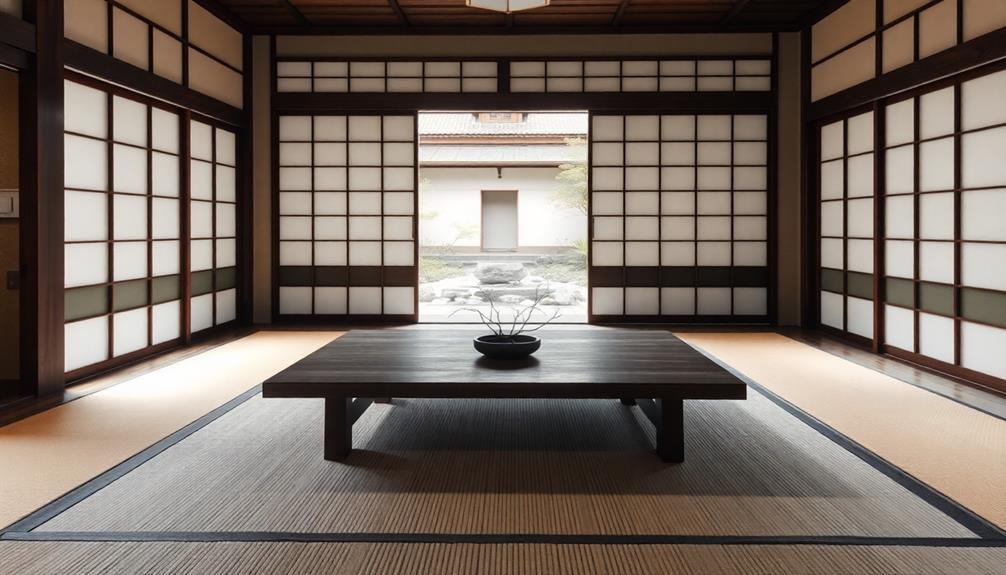
In Japanese interior design, there's a profound connection between simplicity and cultural philosophy, rooted in Zen Buddhism. This design approach emphasizes mindfulness and functionality, guiding you to eliminate both physical and mental clutter.
By embracing concepts from igniting creativity, such as nurturing an imaginative mindset, you allow for a more intentional living space. Concepts like Ma, or negative space, help create a sense of openness, while Wabi-Sabi allows you to appreciate beauty in imperfection.
Using natural materials such as wood, bamboo, and stone, you invite a serene atmosphere into your space. Traditional elements like Shoji screens and Tatami mats reflect simplicity and elegance, promoting a harmonious balance between indoors and outdoors.
Key Design Principles
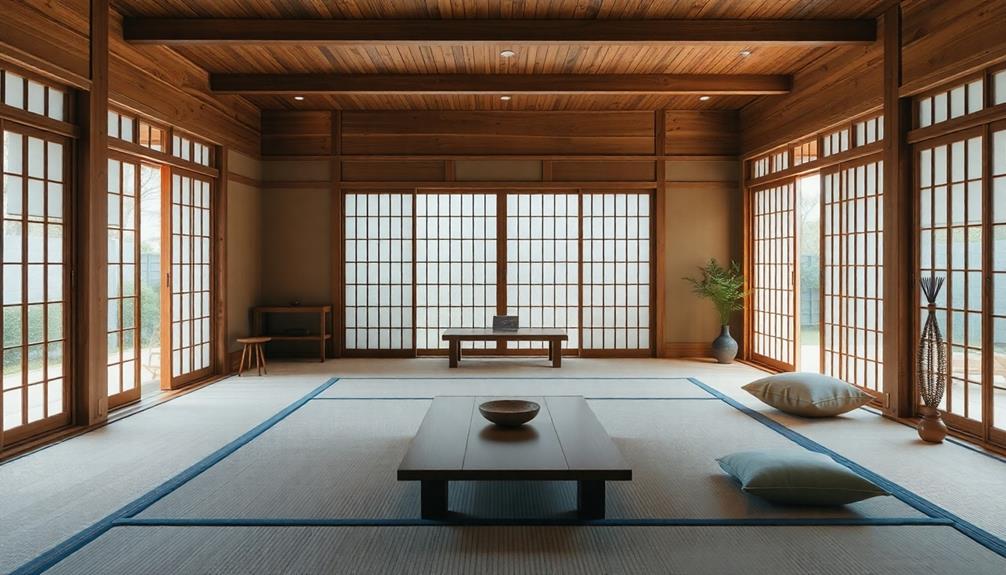
Emphasizing simplicity and minimalism, Japanese interior design is shaped by key principles that create a tranquil and harmonious living space.
To achieve this serene ambiance, focus on these essential elements:
1. Natural Materials: Use wood, bamboo, and stone to foster a warm, inviting atmosphere that echoes nature.
Integrating elements like vintage furnishings can enhance authenticity, similar to modern farmhouse decor trends that prioritize natural materials.
2. Neutral Color Palettes: Opt for soft, muted tones to enhance tranquility and create a calm environment.
3. Mindful Spatial Organization: Arrange your space thoughtfully, ensuring balance and flow while embracing the concept of Ma (negative space).
Elements of Japanese Aesthetics
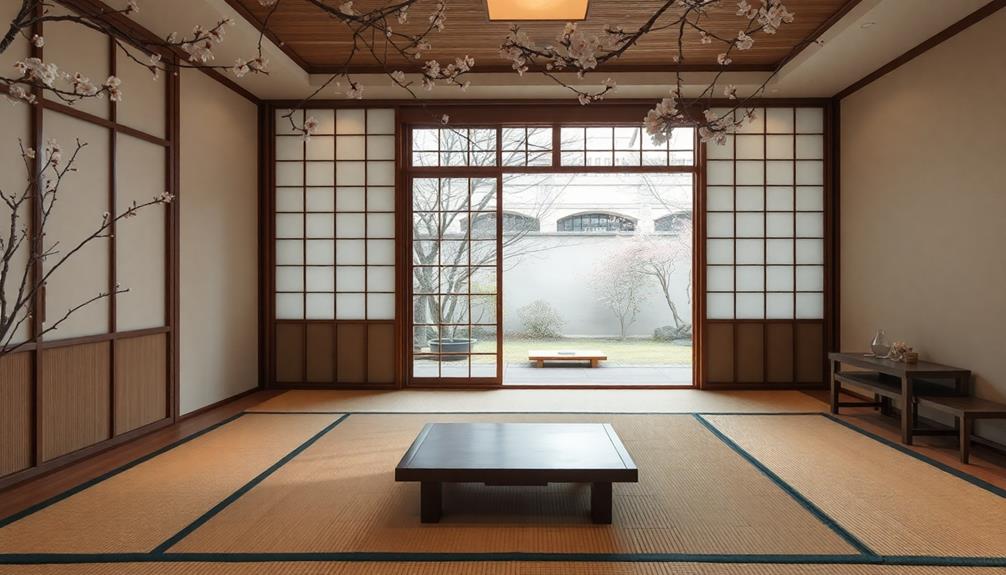
Japanese aesthetics are characterized by a deep appreciation for simplicity, nature, and the beauty found in imperfection. You'll notice this in the way spaces are designed, emphasizing clean lines and uncluttered areas.
Natural materials like wood, bamboo, and stone create a serene atmosphere, while neutral color palettes mimic nature's calming tones. Incorporating elements like indoor plants or bonsai trees enhances the tranquil environment, as these practices are reminiscent of a lifestyle that promotes lifestyle for longevity and well-being.
The principles of Ma, or negative space, invite openness, allowing your space to breathe. Wabi-Sabi embraces the beauty of imperfection, reminding you that flaws can add character.
Global Influence and Appeal
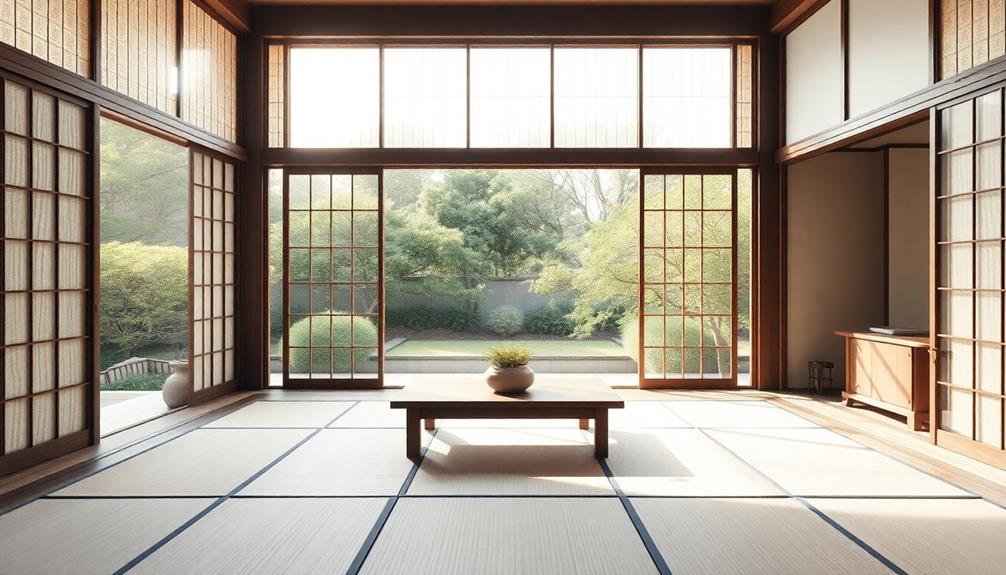
With its serene beauty and minimalist approach, Japanese design has captivated audiences worldwide, transcending cultural boundaries.
You'll find that its principles promote tranquility and simplicity, appealing to many seeking a peaceful environment.
Here are three key reasons why Japanese design resonates globally:
- Wabi-Sabi: This philosophy embraces imperfection and transience, adding depth and character to spaces.
- Ma: The concept of negative space fosters openness and simplicity, encouraging mindfulness in your living area.
- Natural Materials: Using wood, bamboo, and stone creates a calming atmosphere that connects you with nature.
As you explore Japanese interior design, you'll notice how these elements inspire a broader movement toward serene, clutter-free living worldwide.
Comparison With Other Styles
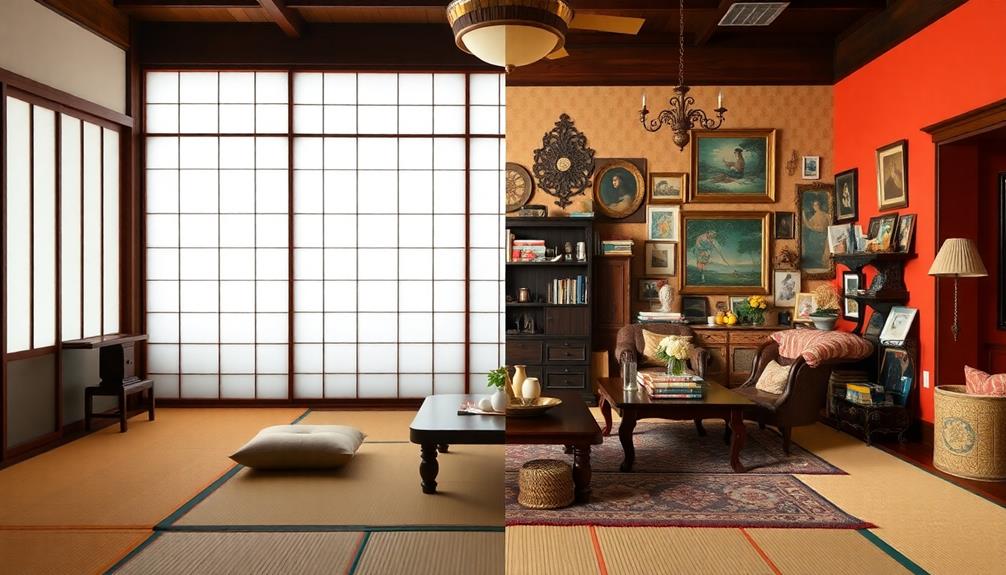
Interior design styles can greatly influence how we perceive and experience our living spaces. When comparing Japanese minimalism with styles like maximalism, the differences become clear.
Maximalism embraces bold colors, diverse patterns, and intricate textures, creating a vibrant and eclectic atmosphere. In contrast, Japanese minimalism prioritizes tranquility and simplicity, focusing on clean lines and natural materials.
While maximalism aims for visual richness, Japanese design fosters a serene environment that promotes mindfulness and balance. This stark contrast highlights how each style caters to different preferences.
If you seek calm and understated elegance, Japanese minimalism might resonate with you. On the other hand, if you love bold, energetic spaces, maximalism could be your ideal choice.
Future Trends in Decor
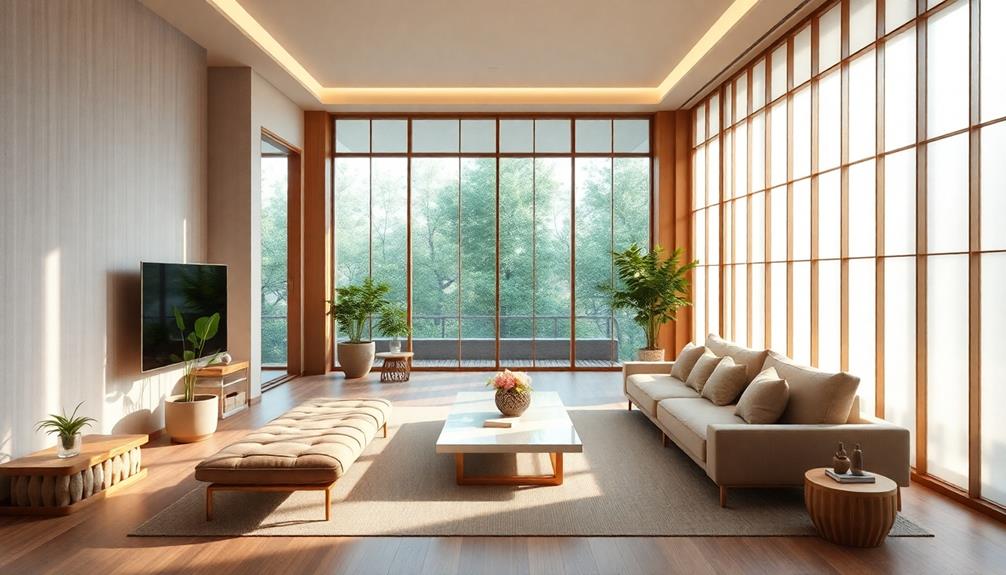
As we look ahead, the future of decor is being reshaped by innovative technologies that seamlessly integrate into our living spaces.
You'll notice a shift toward designs that prioritize functionality and wellness, aligning with the principles of Japanese minimalism.
Here are three trends to watch:
- Multifunctional Furniture: Pieces that serve multiple purposes, like a sofa bed or an expandable dining table, will become staples in homes.
- Sustainable Materials: Expect to see a rise in eco-friendly materials that offer both aesthetic appeal and environmental consciousness.
- Personalized Spaces: Smart technology will allow you to customize lighting, temperature, and even scents, creating a space that truly reflects your personality.
These trends will enhance your living experience, marrying simplicity with modern convenience.
Integrating Technology and Design
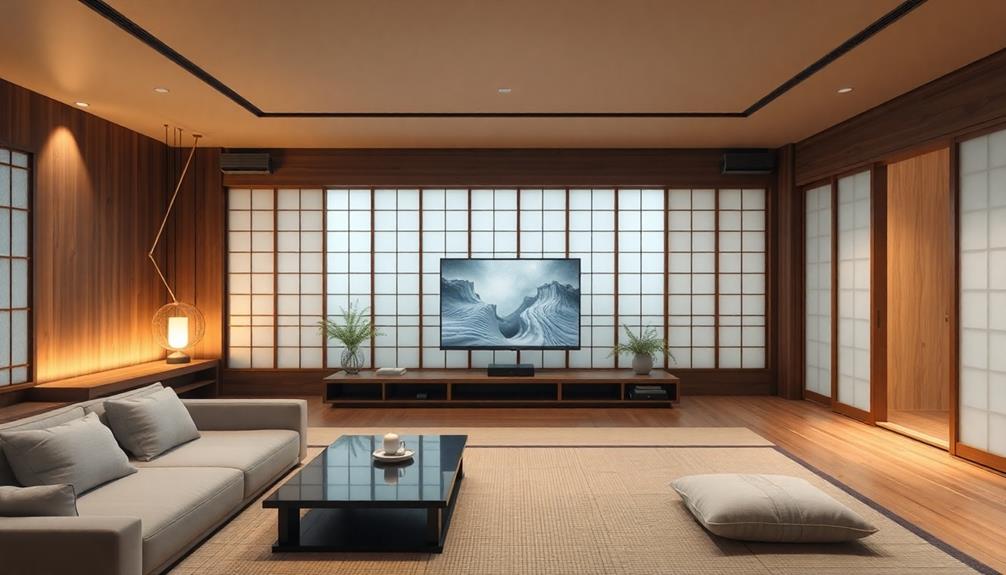
The integration of technology into design is reshaping how you experience your living space. Imagine smart furniture that adapts to your needs, like adjustable desks that promote wellness during long work hours.
With multifunctional coffee tables and sleep-monitoring mattresses, you're embracing convenience without sacrificing style. These innovations enhance your life, simplifying daily tasks while aligning seamlessly with minimalist aesthetics.
Wireless charging stations blend into your decor, eliminating clutter and maintaining the clean lines characteristic of Japanese design.
Voice command systems allow you to control lighting and temperature effortlessly, creating a tranquil environment at your command.
This fusion of technology and design not only enhances functionality but also preserves the serenity that Japanese minimalism embodies, making your home a true sanctuary.
Frequently Asked Questions
How Can I Incorporate Japanese Minimalism Into a Small Space?
To incorporate Japanese minimalism into your small space, focus on decluttering, using natural materials, and selecting multifunctional furniture. Embrace neutral colors, add indoor plants, and create open areas to enhance tranquility and balance.
What Are the Key Colors Used in Japanese Interior Design?
Imagine a serene landscape; that's the essence of Japanese interior design colors. You'll find soft neutrals like beige and gray, accented with earthy tones such as muted greens and browns, creating a tranquil, harmonious atmosphere.
Are There Specific Furniture Styles That Embody Japanese Minimalism?
Yes, specific furniture styles embody minimalist principles. You'll find low-profile pieces, multifunctional designs, and natural materials that emphasize simplicity. Look for clean lines and understated elegance to create a tranquil, harmonious living space. Many minimalist furniture pieces also focus on neutral color palettes that blend seamlessly into a variety of spaces, promoting a sense of calm. Just as simple mehndi designs for beginners focus on uncomplicated patterns to achieve beauty and balance, minimalist furniture relies on subtle details and intentional elements to make a statement. The result is an environment that feels open, uncluttered, and effortlessly inviting.
How Does Japanese Minimalism Influence Outdoor Spaces?
Imagine a calm pond, reflecting the sky. Japanese minimalism influences outdoor spaces by embracing natural elements, promoting tranquility, and encouraging harmony with nature. You'll find serenity in simplicity, inviting peace into your life.
What Maintenance Is Required for Natural Materials in Japanese Design?
To maintain natural materials, you should regularly clean surfaces, apply protective finishes, and avoid harsh chemicals. Keep wood and bamboo away from excessive moisture, ensuring proper ventilation to prevent warping or mold growth.
Conclusion
Embrace the art of simplicity in your own life, transforming your space into a sanctuary of tranquility. Just as a gentle breeze stirs the leaves, let the principles of Japanese interior design refresh your home and spirit. By prioritizing mindfulness and harmony, you'll find beauty in the everyday and discover the profound calm that comes from living with less. Remember, each element you choose can tell a story, inviting peace and serenity into your world.
